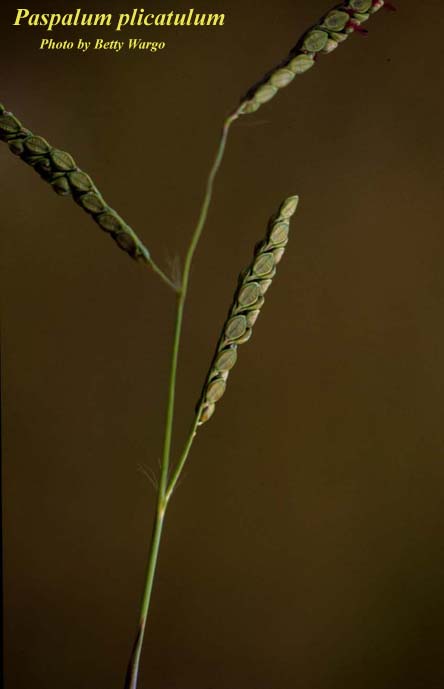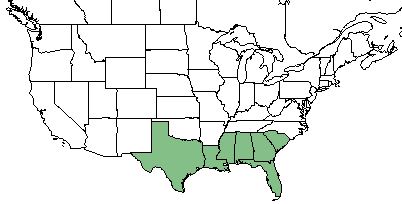Difference between revisions of "Paspalum plicatulum"
Emmazeitler (talk | contribs) |
|||
| Line 1: | Line 1: | ||
{{italic title}} | {{italic title}} | ||
| − | Common name: | + | Common name: Brownseed paspalum<ref name= "USDA Plant Database"/> |
<!-- Get the taxonomy information from the NRCS Plants database --> | <!-- Get the taxonomy information from the NRCS Plants database --> | ||
{{taxobox | {{taxobox | ||
| Line 19: | Line 19: | ||
}} | }} | ||
==Taxonomic Notes== | ==Taxonomic Notes== | ||
| − | Synonyms: none | + | Synonyms: none.<ref name="weakley">Weakley, A.S. 2015. Flora of the southern and mid-atlantic states. Working Draft of 21 May 2015. University of North Carolina at Chapel Hill, Chapel Hill, North Carolina.</ref> |
| − | Varieties: none | + | Varieties: none.<ref name="weakley">Weakley, A.S. 2015. Flora of the southern and mid-atlantic states. Working Draft of 21 May 2015. University of North Carolina at Chapel Hill, Chapel Hill, North Carolina.</ref> |
==Description== | ==Description== | ||
<!-- Basic life history facts such as annual/perrenial, monoecious/dioecious, root morphology, seed type, etc. --> | <!-- Basic life history facts such as annual/perrenial, monoecious/dioecious, root morphology, seed type, etc. --> | ||
| − | ''P. plicatulum'' is a perennial graminoid of the ''Poaceae'' family native to North America, Puerto Rico, and the U.S. Virgin Islands. <ref name= "USDA Plant Database"> USDA Plant Database [https://plants.usda.gov/core/profile?symbol=PAPL3 https://plants.usda.gov/core/profile?symbol=PAPL3] </ref> | + | ''P. plicatulum'' is a cespitose, perennial graminoid of the ''Poaceae'' family native to North America, Puerto Rico, and the U.S. Virgin Islands.<ref name= "USDA Plant Database"> USDA Plant Database [https://plants.usda.gov/core/profile?symbol=PAPL3 https://plants.usda.gov/core/profile?symbol=PAPL3]</ref> The culms are 4-7 dm tall with glabrous nodes and internodes. The blades are 15 cm long, 1-4 mm wide, usually involute, glabrous on both surfaces, and basally pilose. The sheaths are glabrous, have scarious margins, and 2 mm long ligules. There are 2-3 racemes that are racemose, ascending, and 3-5 cm long. The rachis wing is scaberulous and 1 mm wide. Spikelets are ellipsoid, obtuse, 2.5-2.8 mm long, and grow in 2 rows with 2 abortive rows.<ref name="radford">Radford, A. E., Ahles, H. E., & Bell, C. R. (1968). Manual of the vascular flora of the Carolinas. Chapel Hill: University of North Carolina Press.</ref> |
==Distribution== | ==Distribution== | ||
| − | ''P. plicatulum'' is found along the southeastern coast of the United States from Texas to South Carolina, as well as Puerto Rico and the U.S. Virgin Islands. <ref name= "USDA Plant Database"/> | + | ''P. plicatulum'' is found along the southeastern coast of the United States from Texas to South Carolina, as well as Puerto Rico and the U.S. Virgin Islands.<ref name= "USDA Plant Database"/> |
==Ecology== | ==Ecology== | ||
===Habitat=== <!--Natural communities, human disturbed habitats, topography, hydrology, soils, light, fire regime requirements for removal of competition, etc.--> | ===Habitat=== <!--Natural communities, human disturbed habitats, topography, hydrology, soils, light, fire regime requirements for removal of competition, etc.--> | ||
| − | ''P. plicatulum'' proliferates in pine savannas and fields. <ref name= "Weakley 2015"> Weakley, A. S. (2015). Flora of the Southern and Mid-Atlantic States. Chapel Hill, NC, University of North Carolina Herbarium. </ref> Specimens have been collected from sandhill | + | ''P. plicatulum'' proliferates in pine savannas and fields.<ref name= "Weakley 2015"> Weakley, A. S. (2015). Flora of the Southern and Mid-Atlantic States. Chapel Hill, NC, University of North Carolina Herbarium. </ref> Specimens have been collected from sandhill communities, sand-oak woodlands, pine flatwoods, swamp clearings, full sun woodlands, pine flatwoods, lakeshores, roadside shoulders, savannas, longleaf pine forests, riverbanks, floodplains, wiregrass sandhills, and grassy clearing with loamy sands.<ref name = "FSU herbarium"> URL: http://herbarium.bio.fsu.edu. Last accessed: June 2018. Collectors: Cecil Slaughter, Marc Minno, Loran C. Anderson, Jake Gruis, R.K. Godfrey, Angus Gholson, R.F> Doren, H. Kurz, Wilson Baker, Sidney McDaniel,R.A. Pursell, R. Kral, J.B. McFarlin, R.E. Perue, R. Komarek, Kurt Blum, Ed Tyson, J.S. McCorkle, J. Dwyer, H. Loftin, William Stimson, J.A. Duke, R>L. Lazor, A.F. Clewell, Annie Schmidt, Ann Johnson, John Kunzer. States and counties: Florida (Clay, Leon, Orange, Calhoun, Gadsden, Wakulla, Franklin, Washington, Walton, Jackson, Santa Rosa, Liberty, Union, Nassau, Levy, Citrus, Holmes, Lee, Gulf) Alabama (Crenshaw) Georgia (Grady, Thomas)</ref> |
===Phenology=== <!--Timing off flowering, fruiting, seed dispersal, and environmental triggers. Cite PanFlora website if appropriate: http://www.gilnelson.com/PanFlora/ --> | ===Phenology=== <!--Timing off flowering, fruiting, seed dispersal, and environmental triggers. Cite PanFlora website if appropriate: http://www.gilnelson.com/PanFlora/ --> | ||
| − | ''P. plicatulum'' has been observed flowering in May | + | ''P. plicatulum'' has been observed flowering in May through July.<ref name= "PanFlora"> Nelson, G. PanFlora: Plant data for the eastern United States with emphasis on the Southeastern Coastal Plains, Florida, and the Florida Panhandle. www.gilnelson.com/PanFlora/ Accessed: 24 MAY 2018 </ref> |
<!--===Seed dispersal===--> | <!--===Seed dispersal===--> | ||
<!--===Seed bank and germination===--> | <!--===Seed bank and germination===--> | ||
===Fire ecology=== <!--Fire tolerance, fire dependence, adaptive fire responses--> | ===Fire ecology=== <!--Fire tolerance, fire dependence, adaptive fire responses--> | ||
| − | ''P. plicatulum'' is not fire resistant, but has medium fire tolerance. <ref name= "USDA Plant Database"/> | + | ''P. plicatulum'' is not fire resistant, but has medium fire tolerance.<ref name= "USDA Plant Database"/> |
<!--===Pollination===--> | <!--===Pollination===--> | ||
===Use by animals=== <!--Herbivory, granivory, insect hosting, etc.--> | ===Use by animals=== <!--Herbivory, granivory, insect hosting, etc.--> | ||
| − | ''P. plicatulum'' has high palatability for browsing and grazing animals. <ref name= "USDA Plant Database"/> | + | ''P. plicatulum'' has high palatability for browsing and grazing animals.<ref name= "USDA Plant Database"/> |
<!--==Diseases and parasites==--> | <!--==Diseases and parasites==--> | ||
Revision as of 19:28, 2 October 2020
Common name: Brownseed paspalum[1]
| Paspalum plicatulum | |
|---|---|

| |
| Photo by Betty Wargo hosted at Atlas of Florida Plants | |
| Scientific classification | |
| Kingdom: | Plantae |
| Division: | Magnoliophyta - Flowering plants |
| Class: | Liliopsida - Moncots |
| Order: | Poales |
| Family: | Poaceae |
| Genus: | Paspalum |
| Species: | P. plicatulum |
| Binomial name | |
| Paspalum plicatulum Michx. | |

| |
| Natural range of Paspalum plicatulum from USDA NRCS Plants Database. | |
Contents
Taxonomic Notes
Synonyms: none.[2]
Varieties: none.[2]
Description
P. plicatulum is a cespitose, perennial graminoid of the Poaceae family native to North America, Puerto Rico, and the U.S. Virgin Islands.[1] The culms are 4-7 dm tall with glabrous nodes and internodes. The blades are 15 cm long, 1-4 mm wide, usually involute, glabrous on both surfaces, and basally pilose. The sheaths are glabrous, have scarious margins, and 2 mm long ligules. There are 2-3 racemes that are racemose, ascending, and 3-5 cm long. The rachis wing is scaberulous and 1 mm wide. Spikelets are ellipsoid, obtuse, 2.5-2.8 mm long, and grow in 2 rows with 2 abortive rows.[3]
Distribution
P. plicatulum is found along the southeastern coast of the United States from Texas to South Carolina, as well as Puerto Rico and the U.S. Virgin Islands.[1]
Ecology
Habitat
P. plicatulum proliferates in pine savannas and fields.[4] Specimens have been collected from sandhill communities, sand-oak woodlands, pine flatwoods, swamp clearings, full sun woodlands, pine flatwoods, lakeshores, roadside shoulders, savannas, longleaf pine forests, riverbanks, floodplains, wiregrass sandhills, and grassy clearing with loamy sands.[5]
Phenology
P. plicatulum has been observed flowering in May through July.[6]
Fire ecology
P. plicatulum is not fire resistant, but has medium fire tolerance.[1]
Use by animals
P. plicatulum has high palatability for browsing and grazing animals.[1]
Conservation and Management
Cultivation and restoration
Photo Gallery
References and notes
- ↑ 1.0 1.1 1.2 1.3 1.4 USDA Plant Database https://plants.usda.gov/core/profile?symbol=PAPL3
- ↑ 2.0 2.1 Weakley, A.S. 2015. Flora of the southern and mid-atlantic states. Working Draft of 21 May 2015. University of North Carolina at Chapel Hill, Chapel Hill, North Carolina.
- ↑ Radford, A. E., Ahles, H. E., & Bell, C. R. (1968). Manual of the vascular flora of the Carolinas. Chapel Hill: University of North Carolina Press.
- ↑ Weakley, A. S. (2015). Flora of the Southern and Mid-Atlantic States. Chapel Hill, NC, University of North Carolina Herbarium.
- ↑ URL: http://herbarium.bio.fsu.edu. Last accessed: June 2018. Collectors: Cecil Slaughter, Marc Minno, Loran C. Anderson, Jake Gruis, R.K. Godfrey, Angus Gholson, R.F> Doren, H. Kurz, Wilson Baker, Sidney McDaniel,R.A. Pursell, R. Kral, J.B. McFarlin, R.E. Perue, R. Komarek, Kurt Blum, Ed Tyson, J.S. McCorkle, J. Dwyer, H. Loftin, William Stimson, J.A. Duke, R>L. Lazor, A.F. Clewell, Annie Schmidt, Ann Johnson, John Kunzer. States and counties: Florida (Clay, Leon, Orange, Calhoun, Gadsden, Wakulla, Franklin, Washington, Walton, Jackson, Santa Rosa, Liberty, Union, Nassau, Levy, Citrus, Holmes, Lee, Gulf) Alabama (Crenshaw) Georgia (Grady, Thomas)
- ↑ Nelson, G. PanFlora: Plant data for the eastern United States with emphasis on the Southeastern Coastal Plains, Florida, and the Florida Panhandle. www.gilnelson.com/PanFlora/ Accessed: 24 MAY 2018